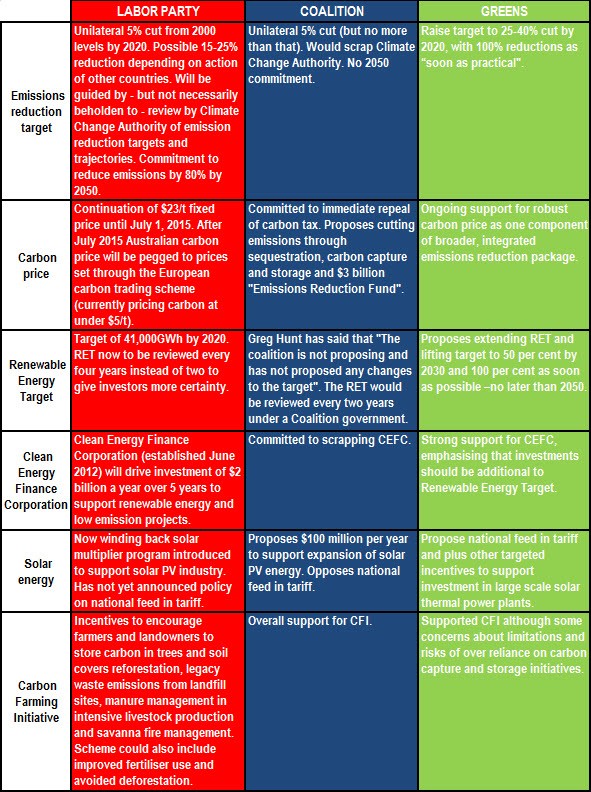
Crikey is collaborating with the Centre for Policy Development to track the major parties’ and The Greens’ election promises. Yesterday, we had a squiz at disability policy and the NDIS. Today, climate change and carbon pricing.
Nearly six years ago, in the heady days of August 2007, former prime minister Kevin Rudd famously called climate change “the great moral challenge of our generation”. That was arguably the high-water mark for political promises on climate change. As the 2010 election drew closer, Rudd’s Carbon Pollution Reduction Scheme, informed by the Garnaut Review, was shelved under unrelenting cabinet pressure from Treasurer Wayne Swan and Julia Gillard.
Then, in the aftermath of Gillard’s narrow election win and with minority Greens demanding a chop out, the PM rolled back her “no carbon tax” pledge, deciding instead to introduce a fixed carbon price of $23 a tonne — a move that looks likely to be dumped after a Coalition victory in September.
The transitional tax levied on the 294 major polluters began on July 1 last year. According to the Clean Energy Regulator — the bureaucracy created to oversee the implementation of the eventual emissions trading scheme — this policy will ultimately effect 60% of the country’s carbon emissions and will include emissions resulting from “electricity generation, stationary energy, landfills, wastewater, industrial processes and fugitive emissions”. It’s difficult to tell at this early stage how successful the tax has been in reducing emissions — emissions are certainly not increasing, but falling demand for electricity (largely unrelated to the carbon price) is a key part of that.
The scientific consensus on carbon is having to kick hard against harsh economic realities. The European carbon market — which under the Australian government’s plan will link to the floating carbon price from 2015 — is in freefall, and German power prices are back, unbelievably, at 2007 levels. US President Barack Obama’s promise to focus on carbon has faded in the aftermath of the global financial crisis, although he has made renewed promises since winning a second term.
But the existential threat to civilisation remains severe. In order to combat this threat, both the government and opposition have committed Australia to reducing emissions by at least 5% of the year 2000’s levels by 2020, with Labor promising a cut of 80% on 2000’s level by 2050. The government intends to reduce each individual Australian’s carbon footprint by one-third to one-half. The carbon pricing scheme makes up only one part of this plan, but it is predicted to reduce carbon emissions by 159 million tonnes per year by 2020, which is roughly equivalent to removing 45 million cars from the roads.
So what are the differences between the parties on climate change? The CPD’s John Wiseman has summarised the differences in this handy table:

And what do the official party platforms say on the topic?
Labor:
The ALP has stated its commitment to restructuring the Australian economy in order to confront climate change. The party intends for this to be achieved through a combination of emissions reduction, investment in renewable energy, support for low-carbon industries, and improvement of current energy efficiency. The party’s platform spruiks a “commitment to ensuring that Australia’s built, environmental, and cultural heritage is conserved for future generations while also safeguarding our future economic competitiveness on the world stage”. It commits to:
- The establishment of the $10 billion Clean Energy Finance Corporation, dedicated “to overcome[ing] capital market barriers that hinder the financing, commercialisation and deployment of renewable energy, energy efficiency and low emissions technologies” (this is already up and running);
- The shift from a fixed to a floating carbon price in 2015;
- Cutting pollution emissions by 80% of 2000 levels by 2050;
- Redistributing the revenue from the carbon pricing scheme to “support jobs and competitiveness, cut taxes and increase payments to help households with the modest price impacts, and build our new clean energy future”; and
- Increasing reliance on clean energy sources from current projected rate of 20% by 2020.
Coalition:
The Coalition has based its climate policy for the next election on abolishing the carbon tax. Five climate agencies will go (Clean Energy Finance Corporation, the Energy Security Council, the Climate Change Authority, the Climate Commission and the Global Carbon Capture and Storage Institute). In its place the Coalition will establish a “direct action” Emissions Reduction Fund (cruelly dubbed “soil magic” in some quarters) with a budget of $3.2 billion, with the aim of reducing emissions by 140 million tonnes per year by 2020. This will match the Gillard government’s goal of a 5% reduction in year 2000 levels of pollution. The fund will create financial incentives for companies to reduce their emissions levels. Furthermore, the Coalition will:
- Use the fund to support direct action on forestry, energy efficiency, and recycling;
- Establish ‘Clean Energy Hubs’ in the Latrobe, Hunter and central Queensland regions;
- Invest $100 million each year so as to encourage solar energy in households;
- Establish 125 mid-scale solar projects and 25 geothermal or tidal power ‘micro’ projects; and
- Initiate bio-sequestration of carbon — essentially, storing carbon in soils.
The Greens:
The Greens claim human-induced climate change as the greatest threat we face. They believe that Australia needs to “substantially reduce greenhouse gas emissions, actively support international mitigation measures to reduce global emissions, and plan to adapt to climate change impacts which are now inevitable”. Here are the policies the Greens wish to enact:
- A net zero carbon economy through market-based and regulatory mechanisms
- A national system of energy efficient targets and Minimum Energy Performance Standard (MEPS) for products, buildings, and infrastructure
- 100% reliance on renewable energy sources for stationary electricity as soon as possible
- No new coal-power stations or mines, or expansion to existing power stations or mines
- Research into sustainable alternative fuels.








Classic coalition policy: govern for the short term interests for the few at the expense of the long term interests for the many.
Amazing how all the parties avoid adding the words “and less gas” to their list of cuts. Could it be that their solutions all implicitly include the words, “and more gas“?
We are being fobbed off. Perhaps we should listen instead to heavy industry to find out what they see as effective solutions.
Considering how many orders of magnitude the coalition’s estimates on how much soil will be needed for their policies tend to be off by, “soil magic” seems generous.
Yeah, less soil magic, more soil alchemy.
“the PM rolled back her “no carbon tax” pledge, deciding instead to introduce a fixed carbon price of $23 a tonne”
So a carbon “tax” is exactly the same thing as a carbon “price”? Does this mean I don’t pay any income “tax” like I think I do according to my payslip, but but I pay an income “price”?
Please explain.